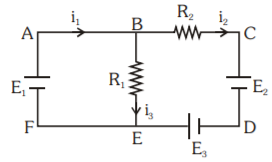What is Kirchhoff's loop rule.
Step-by-Step Solution:
1. Understanding the Concept: Kirchhoff's Loop Rule is based on the principle of conservation of energy. It states that the total energy gained per unit charge (voltage) around any closed loop in a circuit must equal the total energy lost per unit charge.
2. Defining the Loop: To apply Kirchhoff's Loop Rule, we first identify a closed loop in the circuit. A closed loop is any continuous path in the circuit that returns to the starting point without any breaks.
3. Identifying Voltage Sources and Drops: Within the loop, we identify all the voltage sources (like batteries) and voltage drops (like across resistors). For example, if there is a battery providing a voltage V and resistors R1 and R2 with voltage drops V1 and V2 respectively, we note these down.
4. Applying the Loop Rule: According to Kirchhoff's Loop Rule, the sum of the potential differences (voltage) around the loop must equal zero. This can be mathematically expressed as:
V−V1−V2=0
Rearranging this gives:
V=V1+V2
5. Conclusion: Thus, Kirchhoff's Loop Rule can be summarized as: The sum of the potential differences (voltage) in a closed loop is equal to zero. This means that the total voltage supplied by sources in the loop is equal to the total voltage drop across the components in the loop.
Final Answer: Kirchhoff's Loop Rule states that the sum of all the potential differences around any closed loop in a circuit is equal to zero.
---
V−V1−V2=0
Rearranging this gives:
V=V1+V2
Topper's Solved these Questions
- CURRENT ELECTRICITYBook:MBD -HARYANA BOARDChapter:CURRENT ELECTRICITYExercise:SHORT ANSWER TYPE QUESTIONS
Explore 9 Videos
- CURRENT ELECTRICITYBook:MBD -HARYANA BOARDChapter:CURRENT ELECTRICITYExercise:LONG ANSWER TYPE QUESTIONS
Explore 6 Videos
- BOARD QUESTION PAPER (SOLVED) - 2019Book:MBD -HARYANA BOARDChapter:BOARD QUESTION PAPER (SOLVED) - 2019Exercise:LONG ANSWER TYPE QUESTIONS
Explore 4 Videos
- DUAL NATURE OF MATTER AND RADIATIONSBook:MBD -HARYANA BOARDChapter:DUAL NATURE OF MATTER AND RADIATIONSExercise:OBJECTIVE TYPE QUESTIONS
Explore 17 Videos
Similar Questions
Knowledge Check
For a the current loops shown in the figu re, kirchhoff's loop rule for the loops AHDCBA and AHDEFGA yields these equations respectively.
 A−30I1−41I3+45=0 and −30I1+21I2−80=0B30I1−41I3+45=0 and 30I1−21I2−80=0C30I1+41I3−45=0 and −30I1+21I2+80=0D−30I1−41I3−45=0 and −30I1+21I2−80=0
A−30I1−41I3+45=0 and −30I1+21I2−80=0B30I1−41I3+45=0 and 30I1−21I2−80=0C30I1+41I3−45=0 and −30I1+21I2+80=0D−30I1−41I3−45=0 and −30I1+21I2−80=0For circuit given the kirchoff's loop rule for loop BCDEB is given by equation
 A−i2R2+E2−E3+i3R1=0Bi2R2+E2−E3−i3R1=0Ci2R2+E2+E3+i3R1=0D−i2R2+E2−E3+i3R1=0
A−i2R2+E2−E3+i3R1=0Bi2R2+E2−E3−i3R1=0Ci2R2+E2+E3+i3R1=0D−i2R2+E2−E3+i3R1=0Assertion (A): Kirchhoff's junction law follows conservation of charge.
Reason (R): Kirchhoff's loop law follows conservation of energy.ABoth (A) and (R) are true and (R) is the correct explanation of (A).BBoth (A) and (R) are true but (R) is not the correct explanation of (A).C(A) is true but (R) is false.D(A) is false and (R) is also false.
KirchhOFf's law
View SolutionState Kirchhoff's rules . Apply Kirchhoff's rules to the loops ACBPA and ACBQA to write the expressions for the currents I1,I2 and I3 in the network .
View SolutionState Kirchhoff's rules. Apply these rules to the loops PRSP and PRQP to write the expressions for the currents I1,I2 and I3 in the given circuit of Fig.

View SolutionState the Kirchhoff's rules used in electric networks. How are these rules justified ?
View SolutionPoint out the right statements about the validity of, Kirchhoff's junction rule
View Solution